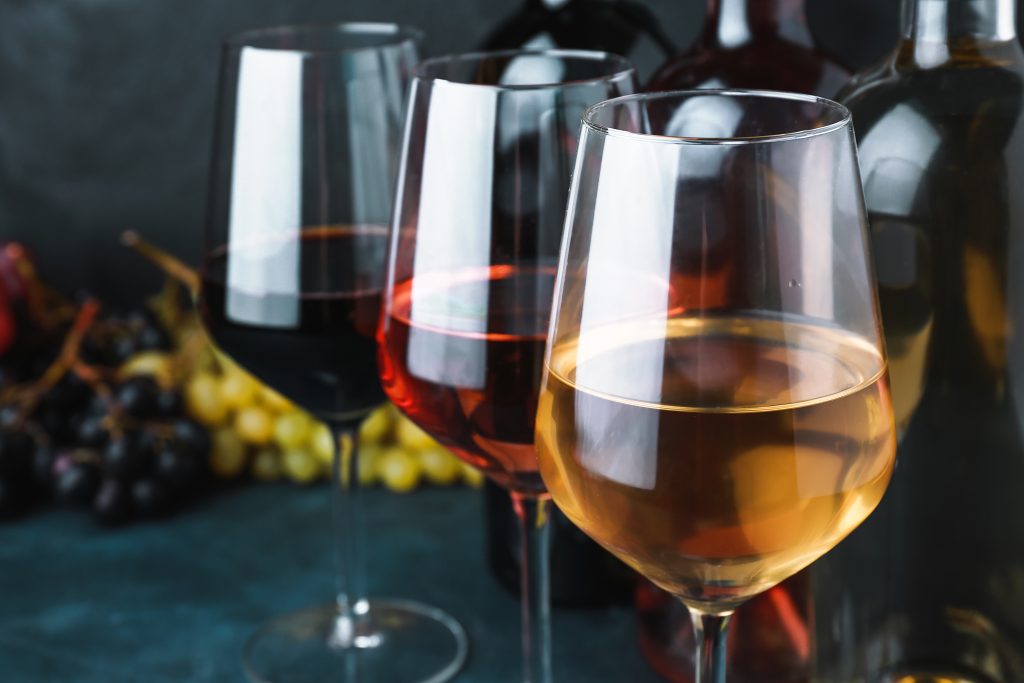In the dim ambiance of a dinner party or during a quiet evening on the balcony, a glass of wine often feels like the perfect companion. Its rich hues and diverse flavours have made it a beloved beverage across civilizations. Yet, as its popularity endures, so do the questions surrounding its impact on our waistline. “Does wine make you gain weight?” or “Does wine make you fat?” – these queries are as old as the tradition of wine-drinking itself.
Understanding the relationship between wine and weight requires delving into its composition. Wine is a complex blend of water, alcohol, carbohydrates, and micronutrients. While its antioxidants and other beneficial compounds have often been highlighted, its caloric content is what comes under scrutiny when weight gain is the topic of concern.
This article aims to pour clarity into the glass of uncertainty surrounding wine’s role in weight management. So, let’s raise a toast to knowledge and explore the intricate dance between wine, calories, and the scales.
Wine’s Calorie Count – Does It Tip the Weight Scale?
For many, a glass of wine at the end of the day or during a meal is a cherished ritual. But if you’re health-conscious or watching your weight, it’s essential to be aware of the caloric content of that relaxing glass. Not all wines are created equal, and the differences can be more than just taste and colour.
White, Red, Rosé, and Sparkling Wine- A Caloric Comparison

- White Wine- Generally, a 5-ounce serving of white wine, such as Chardonnay or Sauvignon Blanc, contains between 120-130 calories. The calorie count can vary depending on the wine’s sugar content. Drier white wines usually have slightly fewer calories than sweeter ones.
- Red Wine- A 5-ounce pour of red wine, like Cabernet Sauvignon or Merlot, typically falls in the 125-130 calorie range. As with white wines, sweeter reds will have a higher caloric content.
- Rosé- Rosé wines, which have gained immense popularity in recent years, can vary significantly in calorie count based on their sugar content. However, most standard dry rosés will have around 120-130 calories for a 5-ounce serving.
- Sparkling Wine- Sparkling wines like Champagne or Prosecco contain anywhere from 90-110 calories in a 5-ounce pour. The variations arise mainly from the sugar content added during the second fermentation, known as the dosage.
Also Check – The Connection Between Alcohol and Weight Gain
Serving Sizes and Their Significance
While the above numbers provide a rough guide, the serving size plays a pivotal role. A typical wine serving is considered to be 5 ounces. But in reality, many people might pour more than this, especially if using larger wine glasses. Being unaware of serving sizes can lead to a significant underestimation of calorie intake.
Moreover, while a 10-20 calorie difference between wine types might seem trivial, over time and with frequent consumption, these small increments can add up. So, it’s vital to be mindful not just of the type of wine you’re drinking but also of how much.
When it comes to wine, the beauty is in its diversity – from the deep reds to the crisp whites. But beyond the bouquet and taste, being informed about its caloric content can help in making mindful choices, especially if weight management is a goal. The key is balance and awareness, ensuring that every sip is as good for the soul as it is for the body.
Health Benefits and Risks of Wine Consumption- Finding the Middle Ground
As you savour that glass of wine, you might’ve come across numerous studies and articles lauding the health benefits of moderate wine consumption. But it’s equally important to understand the potential pitfalls, ensuring that every sip is backed by knowledge.
Resveratrol and Heart Health
One of the key components in red wine that’s garnered attention is resveratrol, a compound found in the skin of grapes. Research suggests that resveratrol has several health benefits, including protecting the blood vessels, reducing the risk of blood clotting, and lowering ‘bad’ cholesterol. Consequently, moderate red wine consumption has often been associated with a reduced risk of certain heart diseases.
However, it’s important to note that while the compound has shown promise, resveratrol supplements have not proven to have the same effects. Thus, if heart health is the goal, a balanced diet rich in fruits and vegetables, whole grains, and lean proteins should be the cornerstone, with wine as a potential complement rather than the main solution.
Also Check – 9 Powerful Strategies to Cultivate a Weight Loss Mindset for Long-Term Success
Balancing Health Benefits Against Caloric Intake
While wine might offer some health perks, it’s crucial to remember its caloric content. The key word here is “moderation.” Drinking wine in excess can quickly tip the balance from potential health benefits to health risks, including weight gain due to extra caloric intake.
Moreover, beyond calories, excessive wine consumption can lead to other health risks such as liver diseases, increased risk of certain cancers, and potential addiction. So, if you’re consuming wine primarily for its purported health benefits, it’s essential to weigh these benefits against the potential risks.
Wine, with its intricate flavours and storied history, does bring some health benefits to the table, especially when enjoyed in moderation. However, it’s essential to be well-informed and balanced in your approach. Remember, while a glass of wine might complement a heart-healthy lifestyle, it’s the broader habits -a balanced diet, regular exercise, and routine health checks- that play the most significant role in overall wellness.
Wine’s Impact on Appetite and Eating Habits- A Double-Edged Sword?
Wine, with its myriad of flavours and aromas, is often hailed as the perfect companion to meals. Yet, while it undoubtedly enhances our dining experience, how does it influence our appetite and eating patterns?
How Wine Can Enhance the Taste of Food
The subtle tannins in wine, particularly reds, can complement the flavours of various foods, making them taste richer and more nuanced. For instance, the acidity in white wines often cuts through the richness of fatty dishes, bringing forth hidden flavours. This synergy between wine and food isn’t just about taste; it’s also about the experience. The act of pairing wine with food encourages mindful eating, where one is more attuned to flavours, textures, and the overall pleasure of the meal.
The Risk of Overeating During Wine Consumption
While wine can be a delightful addition to a meal, it’s essential to be aware of its potential to lower inhibitions. Alcohol, including wine, tends to relax us, making us less conscious of the quantity of food we consume. Couple this with wine’s ability to make food taste better, and you have a recipe for potential overindulgence.
Moreover, research has hinted that alcohol can trigger hunger signals in the brain. It might also impair judgement regarding food choices, leading us to opt for saltier, fattier, or sweeter foods than we might otherwise choose when sober.
Wine’s dance with our taste buds is a testament to its cultural and gastronomic significance. However, the key is always balance. Enjoying wine with meals is an age-old tradition, but it’s essential to remain aware of our intake, both of the wine and the food. By doing so, we can appreciate the enhanced flavours without falling into the trap of overindulgence.
Moderation is Key- Striking the Right Balance with Wine
The saying “too much of a good thing can be bad” holds especially true when it comes to wine. While a glass might enhance a meal or serve as a relaxing evening ritual, understanding the boundaries between enjoyment and overindulgence is essential.
Guidelines for Moderate Wine Consumption
The term “moderate” can be subjective, but there are general guidelines that health experts suggest when it comes to wine. For most adults-
- Women- Up to one 5-ounce glass of wine per day.
- Men- Up to two 5-ounce glasses of wine per day.
It’s crucial to understand that these recommendations don’t mean it’s safe or beneficial to drink this amount daily. Instead, they serve as an upper limit. Factors like age, medication interactions, existing health conditions, and individual tolerance levels can all influence how much wine is appropriate for an individual.
The Difference Between Enjoying Wine and Overindulgence
Enjoying wine revolves around savouring its flavours, pairing it aptly with food, or using it as a means to enhance a social gathering. It’s about appreciation and being present in the moment.
Overindulgence, on the other hand, refers to consuming wine in quantities that might impair judgement, lead to immediate adverse physical reactions, or contribute to long-term health risks. Regular overconsumption can also pave the way for dependency issues and mask or exacerbate mental health challenges.
Wine, with its rich history and cultural significance, can be a delightful addition to various occasions and meals. Yet, the overarching principle remains- moderation. By adhering to guidelines and being attuned to one’s body and mind, it’s entirely possible to relish the pleasures of wine without compromising well-being.
Wine, in its essence, is a harmonious blend of culture, taste, and history. However, as with many delights in life, it comes with both benefits and responsibilities. The lingering question, “Does wine make you gain weight?” or “Does wine make you fat?”, is not solely about wine but about our habits surrounding it. In moderate amounts, wine can be enjoyed without significant weight implications. Yet, coupled with mindless consumption, larger servings, or as an accompaniment to overeating, it can contribute to unwanted calories. As wine enthusiasts, the onus is on us to strike that delicate balance between savouring its richness and being mindful of its effects on our health. After all, the best wine experiences are those that leave us with a feeling of contentment, not regret.
Remember, it’s not just about the wine in your glass, but how you choose to enjoy it.

Leave a Reply